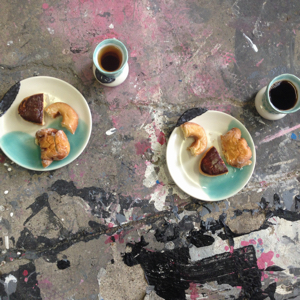Whenever Agnes used the dishes, someone else washed them for her. Joe began thinking about what kind of food he would serve on them, exploring new recipes and indulging his creativity. Jen carried hers into the street and showed them to Melvin, a homeless man, and invited him to share a meal. My dishes sat on the coffee table in our living room for the month of October, a goad to staying true to my participation in the project and a reminder of the people I had eaten with.
All four of us were participating in Project Share, a social practice art piece that Jeni was creating, and that ran concurrently with the Concurrent show in the EASE Gallery. Like all of the artists in that show, Jeni is a ceramicist. A few years ago she went to see a social practice piece in Philadelphia, and was underwhelmed. The piece was about serving tea to people, but the cups and teapot used were mass produced, and the tea was generic. She began to wonder about the power of objects, not just whether the specificity of a given object could enhance social practice work, but whether it could be the engine of the work itself. She’s undertaken many projects to explore this question, one of the most notable being Project NOLA, which took place last Spring. She was interested in what the men who lived under a bridge in New Orleans ate, so she created more than fifty ceramic plates and passed them out, along with disposable cameras. She got four of the cameras back, and one of them contained a food journal that one of the men had kept. Our project, Project Share, was about creating shared meals among strangers. Jeni gave each of us a set of plates and cups, and asked us each to invite a stranger to share a meal.
Social practice art has thrived in Europe for decades now, and has recently begun to grow in the United States. It is art that has a social conscience, that is deliberately trying to marry aesthetics with justice. More than that, it’s art that is intent on creating community, and exploring the questions of community creation during a time in American history when many of our old forms of community are falling apart. Being a member of one of those declining institutions, the church, I am more than interested in Jeni’s experiments, and what they can teach us.
The project was not a complete success. Last night we had a final dinner, to which we were asked to invite the strangers whom we’d eaten with throughout the course of the month. Neither of the people I’d met could come, and I wasn’t alone in this. Only two of the dozen or so guests at the meals we’d held attended. The rest were kept away by work and family conflicts, or by the fact that they’d been met, and then eaten with, in other cities, as we traveled throughout the month. At this point in American life we’re a transient people, and the busyness of our day to day existence means that we look for community within the domains of family and work life, and that any other form of community is a secondary concern at best.
And yet, for those of us who participated, it was a distinctly beautiful experience. The plates Jeni gave us were glazed white with a crescent of turquoise, and a quarter circle fringe of black, molded clay. They were wonderful to look at and to touch. Having them in my living room, and laden with food on the table of a restaurant as I ate with a stranger, made me think of the uniqueness of objects. I have other unique plates and cups in my house. But they’re not charged with experience in the same way – I can’t look at them and remember a certain time in my life, and the people with whom I ate off of them. To use an object for a particular purpose is to gift it with memory, and there is grace in living a life that allows certain memories to remain distinct.
You can visit the Project Share blog by clicking here.

